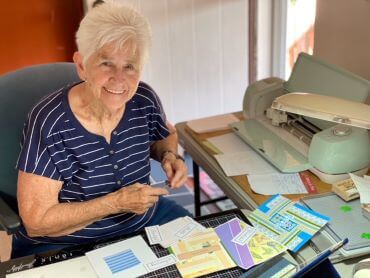A Great-Grandmother's Path to Back Pain Relief
Octogenarian Jean Adams doesn't take aging sitting down.

"You've got to fight it every day with a hammer and a smile," laughs the 84-year-old from Wilkins Township.
Jean knows staying active is key to successful aging, so she swims, walks her dog, and plays with her great-grandkids.
But in late fall 2019, she began having shooting pain spanning from her lower back into her thighs and legs.
"I hadn't fallen or been in an accident," says Jean. “But the pain kept getting worse every day when I stood or walked, until it just became unbearable."
Jean first turned to a chiropractor for relief. When that treatment proved unsuccessful, she turned to her daughter — a doctor at UPMC Shadyside — for advice.
Jean's daughter suggested spine surgeon Mark A. Fye, MD, of Orthopaedic Specialists—UPMC, with offices in Monroeville, White Oak, and the North Hills. He specializes in problems of the neck, back, and sacrum (tailbone).
So, Jean made an appointment in January 2020 with Dr. Fye.
Back Pain in Seniors
"Jean has spinal stenosis, a degenerative spine problem. It causes a narrowing in the spinal canal — the space where the nerves travel down from the spinal column. That creates pressure, which pinches the nerves of the spine," says Dr. Fye.
Regressive conditions like stenosis affect the spine's structure and function.
"Degenerative means these changes relate to aging due to the wear and tear of living," says Dr. Fye.
In Jean's case, an MRI confirmed stenosis and a cyst on her spine that was coming from the facet joint.
The facet cyst squeezed the nerves, causing the pain to travel down the leg from the back.
These noncancerous, fluid-filled cysts often occur in degenerative spine conditions. Along with pain, they can cause numbness and weakness in the legs.
"Back pain that extends into the legs affects people of all ages, but the cause differs by age," adds Dr. Fye. “In my younger patients, a herniated disk is often the cause of spine pain. In older people, stenosis and bone spurs are the most frequent causes of pain."
This not only can affect the back but the neck, too, causing arm pain, numbness, and weakness.
The Solution: Minimally Invasive Surgery to Resolve Spinal Stenosis and a Facet Cyst
"We normally start with nonsurgical options to treat pain, using both medicine — such as prednisone or anti-inflammatories — and physical therapy. But problems that persist or progress, like Jean's, are best resolved with minimally invasive spinal surgery," says Dr. Fye.
"I didn't hesitate to choose surgery," says Jean. "I knew I was in good hands and I didn't just want to mask my pain. I wanted a long-term fix."
She had surgery at the UPMC East Spine and Pain Program in late February.
Dr. Fye did a minimally invasive hemilaminectomy to remove the facet cyst off the nerves in the spine column. While it's often an outpatient procedure, Jean stayed overnight at the hospital for observation as a precaution due to her age.
The Results: Pain-Free Right Away
"I was pain-free right away after the surgery. I'm back to feeling myself again," says Jean.
She tapped into her artistic skills and began making handmade cards for Dr. Fye and his staff. Jean personalized each card based on their interests and personalities.
Two weeks after surgery, she stopped by his office to present the cards as a sign of gratitude.
"I know one thing for sure," says Jean. “I'd go back to Dr. Fye in a heartbeat if I ever need surgery again."
Note: This patient’s treatment and results may not be representative of all similar cases.
















